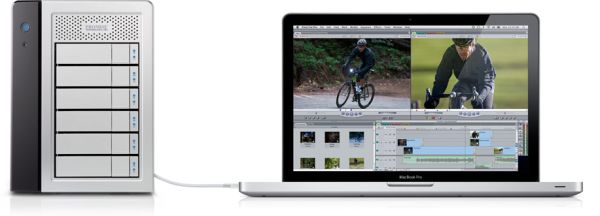MacBook Pro 2011 Refresh: Specs and Details
by Andrew Cunningham on February 24, 2011 4:40 PM ESTThunderbolt
The new MacBook Pros offer the array of ports we're used to, plus something a bit different.
A new port called Thunderbolt replaces the Mini DisplayPort found in earlier models. Formerly codenamed Light Peak, the new Intel standard promises up to 10 Gbps bi-directional data transfer speeds and connectivity for an array of devices, from displays to hard drives. The standard also supports 8-channel audio, which should make for easy connection to HDMI devices with the right adapter, and up to six different Thunderbolt devices can be daisy chained together according to the Intel specs.
Most of the given use scenarios for Thunderbolt focus on external hard drives, displays, and HD video hardware, and adapters for existing standards like eSATA and Firewire. If Thunderbolt ports become more widespread, we'll probably see additional applications of the standard.

Finally, it's worth noting that if you've already spent money on Mini DisplayPort adapters, dongles and cables for your existing Mac, those accessories will continue to work with the new Thunderbolt port.
Look for more from us on Thunderbolt shortly.
Conclusions
Thunderbolt aside, there's not much that surprises about the new MacBook Pro lineup - as usual, new, faster hardware is being sold to us in the same attractive unibody case to which we've become accustomed.
Most of the additions are welcome, though the value proposition continues to be a struggle. As usual, to save money, you're better off buying the base model and adding RAM or a new hard drive yourself than paying Apple's price for upgrades.
The move to Sandy Bridge is interesting but the lack of any mention of Quick Sync is a bit bothersome. We’re working on our review of the new platforms, expect to see results in the coming days.











128 Comments
View All Comments
TareX - Thursday, February 24, 2011 - link
How does the screen compare to the HP Envy 14's that came with a 900p Radiance display?Exelius - Thursday, February 24, 2011 - link
Apple's displays have always been best-in-class. My 15" MBP has a 1680x1050 display and the quality of the display is the best I've seen. The radiance displays HP used were generally considered to be on-par with Apple's displays. The high-quality display is a large part of why MBPs are so expensive.seapeople - Thursday, February 24, 2011 - link
Correction, the high-quality display is ~5% of why MBP's are so expensive.It's not like the thing is IPS or something.
nikclev - Friday, February 25, 2011 - link
Interesting. I was under the impression that the display WAS in fact an IPS panel.Either way, I'm not an apple hater, but for my uses they are too expensive.
Penti - Sunday, February 27, 2011 - link
Well displays are actually pretty pricey even if they are not IPS. The anti-glare high-res upgrade is $150 extra to boot. I would guess the screen is as much as one-twelfth to one-tenth. For a repair the high-res anti-glare would cost, the same panel that is, around 300 dollars for the part. You couldn't get an equivalent for less then 199 USD. On cheap laptops the screen is a quarter of the price.Penti - Sunday, February 27, 2011 - link
Of course there is a problem that screens like the dreamcolor display (LG.PH from HP) uses 15W. However you can get that display for $150. Which HP charges $550 for to upgrade.Penti - Sunday, February 27, 2011 - link
I.e. it's quite a different matter @ 17".erple2 - Thursday, February 24, 2011 - link
Technically, the displays have always been high quality, but not quite best in class. For the $2500 17" notebook variants, there is a Dell and HP that offers a better display ("Dreamcolor" from HP and the RGBLED display from DELL). Those are business oriented laptops, however.Similar story for the 15" ones from Dell/HP. Those are, however, the top displays available in mobile form factors for somewhere within reason of the MBP offerings.
solofest - Thursday, February 24, 2011 - link
The high-end 13" has an i7, not an i5.RaLX - Thursday, February 24, 2011 - link
The 13" and 15" base models upgrades are like giving one step ahead in CPU and one step back in GPU... It's not worthy at all upgrading if you already own a 2010 model.These new models are probably cheaper to build for Apple and they sell it at the same price so the only real upgrade is the profits per unit for them...